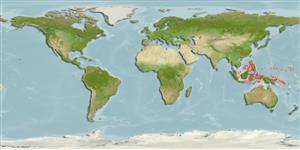Classification / Names
Common names from other countries
Main reference
Size / Weight / Age
Max length : 7.5 cm SL male/unsexed; (Ref. 57884); 8.2 cm SL (female)
Environment
Marine; benthopelagic; depth range 0 - 16 m (Ref. 57884)
Climate / Range
Tropical, preferred ?
Distribution
Western Central Pacific: from the Philippines to the northern tip of Sulawesi (Indonesia) in the west and the oceanic islands of Palau, Pohnpei (Micronesia) and Hermit (PNG) islands in the east.
Countries | FAO areas | Ecosystems | Occurrences | Introductions
Short description
Dorsal
soft rays
(total): 78-83;
Anal
soft rays: 61 - 68;
Vertebrae: 43 - 46. This species is characterized by the following: Vertebrae 11-12+32-35=43-46, dorsal fin rays 78-83, anal fin rays 61-68; very large eyes (2.7-3.8% SL), D/V 7; outer pseudoclasper large, about 1 1/2 length of inner pseudoclasper, wing-shaped, flat and its posterior part strongly bent backward; inner pseudoclasper joined to outer pseudoclasper anteriorly, long, single-pointed tip strongly extending over anterior part of inner pseudoclasper; scale patch on cheek with 5-6 scale rows on upper cheek, large scale patch on operculum continuous above and below opercular spine; head high, usually high-necked; otolith length to height ratio 2.0-2.1 (Ref. 57884).
IUCN Red List Status (Ref. 115185)
Threat to humans
Harmless
Human uses
More information
Common namesSynonymsMetabolismPredatorsEcotoxicologyReproductionMaturitySpawningFecundityEggsEgg development
Age/SizeGrowthLength-weightLength-lengthLength-frequenciesMorphometricsMorphologyLarvaeLarval dynamicsRecruitmentAbundance
ReferencesAquacultureAquaculture profileStrainsGeneticsAllele frequenciesHeritabilityDiseasesProcessingMass conversion
Tools
Special reports
Download XML
Internet sources
Estimates of some properties based on models
Phylogenetic diversity index
PD50 = 0.5000 many relatives (e.g. carps) 0.5 - 2.0 few relatives (e.g. lungfishes)
Trophic Level
3.2 ±0.5 se; Based on size and trophs of closest relatives
Resilience
High, minimum population doubling time less than 15 months (Preliminary K or Fecundity.)
Vulnerability
Low vulnerability (15 of 100)
Price category
